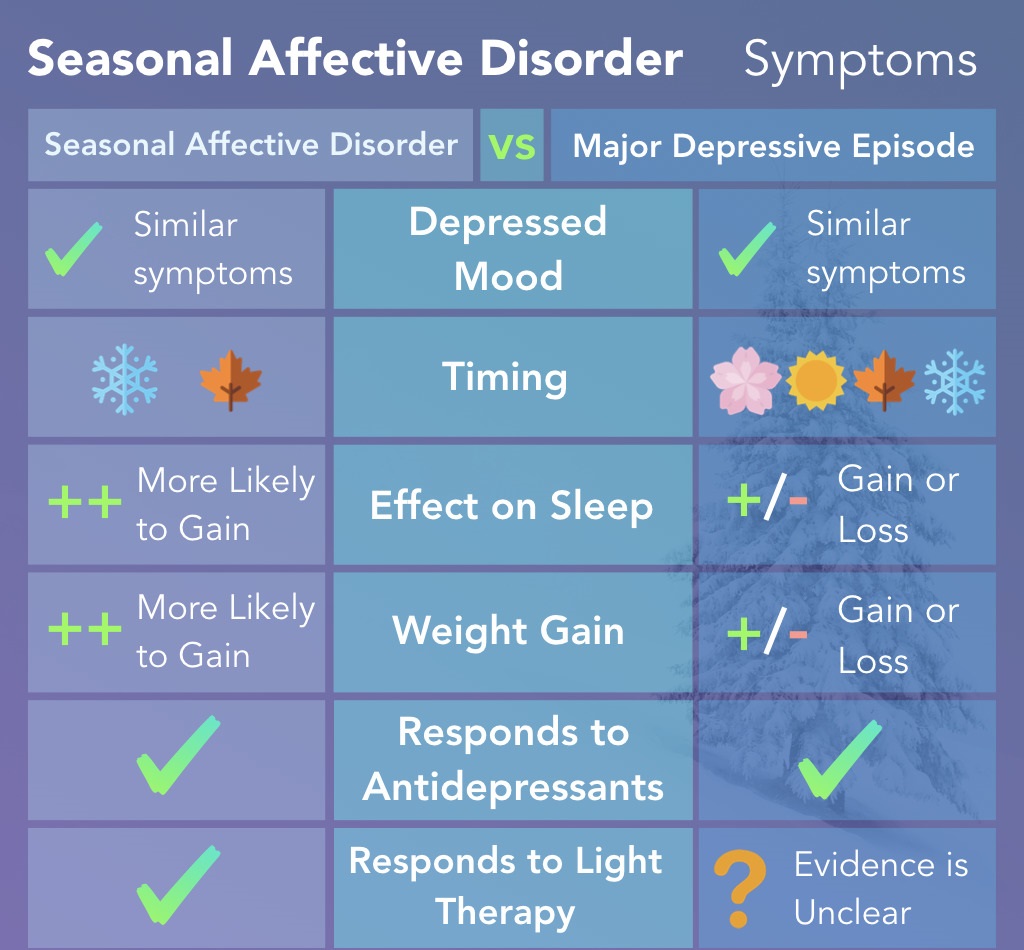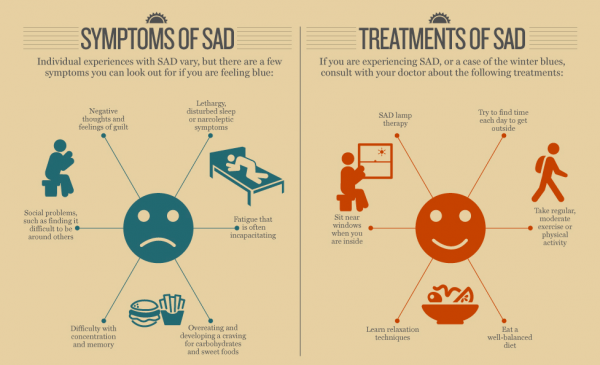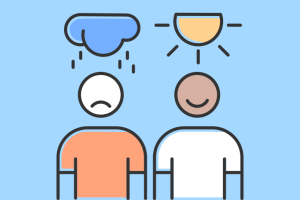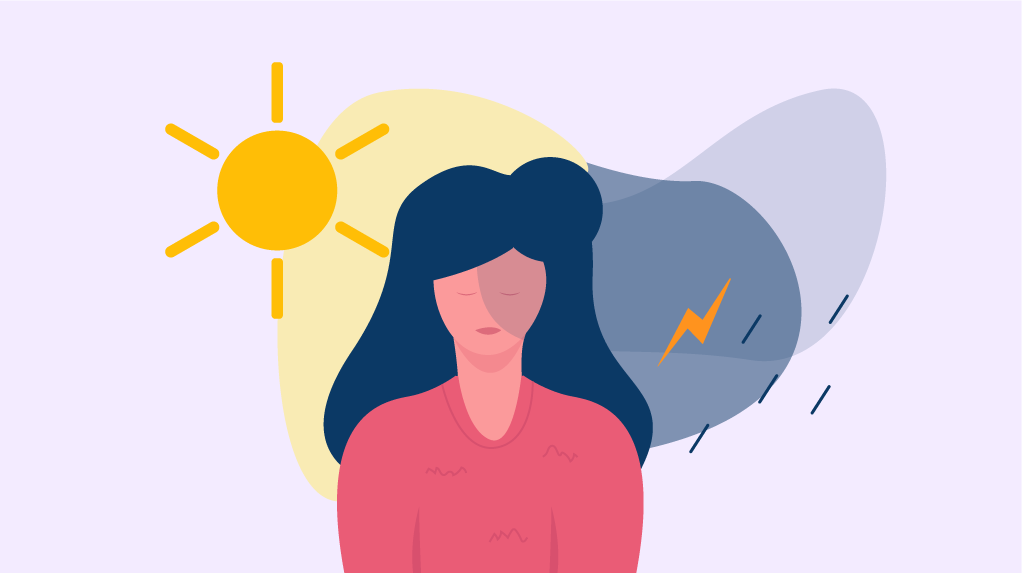Do you feel a little down during the winter months? Do you feel like you can’t get out of bed in the morning? If so, you may be suffering from the seasonal affective disorder, or SAD. SAD is a form of depression that occurs during certain times of the year.
It is most commonly seen during the winter months. But it can also occur during other seasons. In this blog post, we will discuss what seasonal affective disorder is. Also how to cope with it, and the possible outcomes of living with SAD.
Contents
Understanding Seasonal Affective Disorder

The seasonal affective disorder is a type of depression that occurs during certain times of the year. It is most commonly seen during the winter months. But it can also occur during other seasons.
NOTE: It is estimated that about one in fifteen people experiences seasonal affective disorder.
What Are Types Of Seasonal Affective Disorder?
There are three different types of seasonal affective disorder:
Winter-onset SAD: This type of SAD occurs during the winter months. It is the most common type of SAD.
Summer-SAD: This type of SAD occurs during the summer months. It is less common than winter-onset SAD.
Seasonal-Atypical Depression: This type of SAD does not occur during a specific season. It can happen at any time of the year.
NOTE: The symptoms of atypical depression are different than the symptoms of the major depressive episode with seasonal patterns.
What Are The Symptoms Of Seasonal Affective Disorder?

The symptoms of SAD can vary depending on the type of SAD you have. However, some common symptoms include:
Depression: This includes feelings of sadness, worthlessness, and hopelessness.
Anxiety: This includes feeling restless or tense, having trouble sleeping, and experiencing panic attacks.
Loss Of Interest In Activities: This includes not enjoying activities that you usually enjoy, having less energy, and feeling like you can’t concentrate.
Weight Gain/Loss: This includes changes in weight without changing your diet or exercise habits.
Changes In Sleep Habits: This includes sleeping too much or too little, having trouble falling asleep, and waking up frequently during the night.
Changes In Appetite: This includes eating more or less than usual, cravings for specific foods, and not being able to eat anything.
What Are The Degrees Of Seasonal Affective Disorder?
The signs and symptoms of the seasonal affective disorder can vary from person to person. However, some of the most common symptoms include:
Mild: This is the least severe type of SAD. It includes symptoms like a decreased interest in activities, feeling down or stressed, and changes in sleep habits.
Moderate: This is the middle level of severity for SAD. It includes symptoms like depression, anxiety, and problems with concentration.
Severe: This is the most severe type of SAD. It includes symptoms like suicidal thoughts, hallucinations, and psychosis.
What Are The Causes Of Seasonal Affective Disorder?
The causes of the seasonal affective disorder are still unknown. However, some possible factors may contribute to it including:
Lack Of Sunlight: This includes working indoors or living in a location where there is little sunlight.
Hormones: This includes changes in hormones during different times of the year.
Chemicals In The Brain: This includes chemicals like serotonin and melatonin that may be affected by the changing seasons.
Evaluating Seasonal Affective Disorder
Seasonal affective disorder can affect men and women differently. Women are more likely to experience the winter-onset SAD. While men are more likely to experience summer SAD.
- Women are more likely to experience the symptoms of depression, anxiety, and changes in sleep habits.
- Men are more likely to experience the symptoms of loss of interest in activities, weight gain or loss, and changes in appetite.
What Are Ill-effects Of Seasonal Affective Disorder?
The negative consequences of seasonal affective disorder can vary depending on the severity of your symptoms. However, some common negative consequences include:
Poor Mental Health: This includes depression, anxiety, and suicidal thoughts.
Poor Physical Health: This includes weight gain or loss, changes in sleep habits, and changes in appetite.
Problems With School/Work: This includes problems with concentration, completing tasks, and meeting deadlines.
Relationship Problems: This includes fights with friends or family members, feeling distant from people you care about, and having less interest in sex.
Coping With Seasonal Affective Disorder

There are many different ways that you can cope with seasonal affective disorder. Some self-help tips include:
Getting Enough Sunlight: This includes spending time outside in the sun, using a light therapy box, or taking vitamin D supplements.
Exercising Regularly: This includes going for walks, riding your bike, or swimming.
Eating a Healthy Diet: This includes eating plenty of fruits and vegetables, drinking water instead of sugary drinks, and avoiding processed foods.
Resting Enough: This includes getting enough sleep, taking breaks during the day, and avoiding stressors.
Treatment And Therapies For Seasonal Affective Disorder

There are many different types of treatments and therapies that can help you manage your symptoms of SAD. Some common treatments include:
Light Therapy: This includes using a light therapy box to expose yourself to bright light or taking vitamin D supplements.
Medication: This includes antidepressant medications like selective serotonin reuptake inhibitors (SSRIs) and serotonin-norepinephrine reuptake inhibitors (SNRIs).
Counseling: This includes talking with a therapist about your thoughts and feelings.
Self-Care: This includes things like getting enough sleep, exercising regularly, eating a healthy diet, and resting enough.
What Medications Are Administered In Treating SAD?
There are many different types of antidepressant medications that can be administered in the treatment of seasonal affective disorder. Some common antidepressants include:
Selective Serotonin Reuptake Inhibitors (SSRIs): This includes medications like fluoxetine (Prozac) and sertraline (Zoloft).
Serotonin-Norepinephrine Reuptake Inhibitors (SNRIs): This includes medications like venlafaxine (Effexor) and duloxetine (Cymbalta).
Tricyclic Antidepressants: This includes medications like amitriptyline (Elavil) and imipramine (Tofranil).
Monoamine Oxidase Inhibitors (MAOIs): This includes medications like isocarboxazid (Marplan) and phenelzine (Nardil).
Disclaimer: This is not a comprehensive list of all medications that can be used in the treatment of SAD. Always talk to your doctor about the best medication options for you.
Talking To a Professional
If you are experiencing symptoms of SAD, it is important to talk to a professional. They can help you evaluate your symptoms and determine the best treatment for you.
Case Study
Mary is a 28-year-old woman who has been struggling with symptoms of SAD for the past few years. She has difficulty concentrating at work and her moods have been changing more frequently than usual. Therefore, her doctor recommends that she try light therapy to see if it helps improve her symptoms. After starting light therapy, Mary notices that her moods are more stable. And she can concentrate better at work.
Experts’ View On SAD
Experts often view SAD as a serious mental health condition. It can have negative consequences on your physical health, work, and relationships. However, many positive outcomes can come from managing your symptoms of SAD.
Resources On SAD
Furthermore, if you would like more information on seasonal affective disorder. Then please check out the following resources:
- National Institute of Mental Health: This website provides a lot of information on SAD, including symptoms, treatments, and research.
- American Psychiatric Association: This website provides information on different mental health conditions, including SAD.
Conclusion
Seasonal affective disorder can be a serious mental health condition. That can have negative consequences on your physical health, work, and relationships. However, many positive outcomes can come from managing your symptoms of SAD. Furthermore, if you are experiencing symptoms of SAD, it is important to talk to a professional.
A Word From Therapy Mantra
Your mental health — Your psychological, emotional, and social well-being — has an impact on every aspect of your life. Positive mental health essentially allows you to effectively deal with life’s everyday challenges.
At TherapyMantra, we have a team of therapists who provide affordable online therapy to assist you with issues such as depression, anxiety, stress, workplace Issues, addiction, relationship, OCD, LGBTQ, and PTSD. You can book a free therapy or download our free Android or iOS app.


